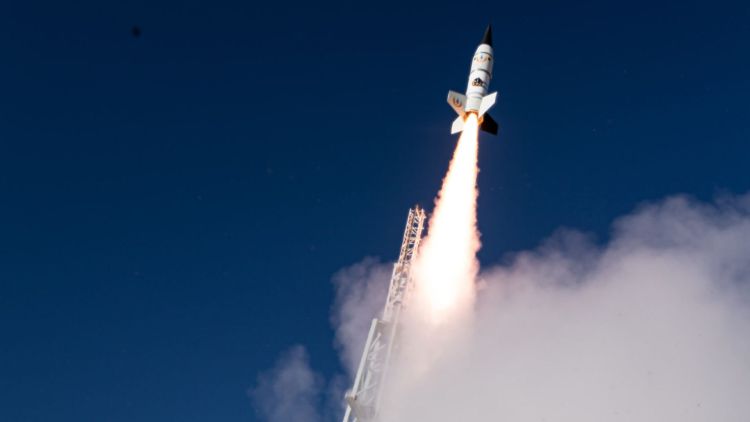X-Bow Systems Inc. (X-Bow) has just marked a significant milestone in defense manufacturing with the third successful flight of its Bolt Rocket. This isn’t just a rocket launch—it’s a step forward for the future of solid rocket motors (SRMs) and what they could mean for the US military.
The XB-32 motor, part of X-Bow’s Bolt rocket family, is the largest advanced manufactured solid propellant motor ever flown, and it’s shaking up what we thought possible in affordable, large-scale SRM production.
So, What’s an SRM, and Why Does it Matter?
Solid rocket motors are an essential part of the modern military and space toolkit. They’re commonly used as boosters to give payloads a lift, whether it’s satellites going into Low Earth Orbit (LEO) or military payloads needing quick, short-distance launches.
Unlike liquid-fuel rockets, which store fuel and oxidizers separately and need pumps to mix them at launch, SRMs store their fuel and oxidizer together in a solid form. This approach requires less maintenance, as the solid propellant remains stable over time without risk of degradation, which makes SRMs a reliable, low-maintenance option for defense and aerospace.
The Bolt Rocket’s SRM is a prime example of how advanced manufacturing can shift the landscape.
X-Bow Systems uses a patented manufacturing process that involves additive manufacturing and 3D printing, which makes producing SRMs faster, more affordable, and scalable. This approach allows for rapid iterations and upgrades to meet the evolving needs of defense contractors and commercial users.
As X-Bow CEO Jason Hundley put it, they’re able to “design, produce, and test SRMs with unprecedented speed, precision, and scalability.”
Why is This Important for the US Military?
Let’s talk about why the US military is paying attention to what X-Bow is doing with the Bolt Rocket.
X-Bow Systems Inc. (X-Bow) has just marked a significant milestone in defense manufacturing with the third successful flight of its Bolt Rocket. This isn’t just a rocket launch—it’s a step forward for the future of solid rocket motors (SRMs) and what they could mean for the US military.
The XB-32 motor, part of X-Bow’s Bolt rocket family, is the largest advanced manufactured solid propellant motor ever flown, and it’s shaking up what we thought possible in affordable, large-scale SRM production.
So, What’s an SRM, and Why Does it Matter?
Solid rocket motors are an essential part of the modern military and space toolkit. They’re commonly used as boosters to give payloads a lift, whether it’s satellites going into Low Earth Orbit (LEO) or military payloads needing quick, short-distance launches.
Unlike liquid-fuel rockets, which store fuel and oxidizers separately and need pumps to mix them at launch, SRMs store their fuel and oxidizer together in a solid form. This approach requires less maintenance, as the solid propellant remains stable over time without risk of degradation, which makes SRMs a reliable, low-maintenance option for defense and aerospace.
The Bolt Rocket’s SRM is a prime example of how advanced manufacturing can shift the landscape.
X-Bow Systems uses a patented manufacturing process that involves additive manufacturing and 3D printing, which makes producing SRMs faster, more affordable, and scalable. This approach allows for rapid iterations and upgrades to meet the evolving needs of defense contractors and commercial users.
As X-Bow CEO Jason Hundley put it, they’re able to “design, produce, and test SRMs with unprecedented speed, precision, and scalability.”
Why is This Important for the US Military?
Let’s talk about why the US military is paying attention to what X-Bow is doing with the Bolt Rocket.
Traditionally, developing and producing SRMs has been a lengthy and costly process.
The Cold War-era model of stockpiling large numbers of rockets isn’t sustainable in an age where threats and technologies change rapidly.
X-Bow is offering a new way forward with a faster, more flexible production method that allows SRMs to be customized for specific missions and manufactured on-demand, potentially avoiding the lengthy stockpiling process.
Moreover, the success of X-Bow’s third flight test for the Bolt Rocket sends a clear message: this technology works, and it can scale.
The recent Commercial Mission-1 (CM-1) flight validated its in-house design and manufacturing process, collecting data to fine-tune the SRM’s performance and prove its reliability.
This success caught the attention of sponsors like the Defense Innovation Unit (DIU) and the US Army Space and Missile Defense Command, highlighting how X-Bow’s modular, “digital twin” technology and rapid production approach could redefine SRM manufacturing for military needs.
What’s Next for the Bolt Rocket and SRMs?
With the success of the latest flight, X-Bow’s Bolt rocket family is now preparing for additional missions in partnership with Los Alamos National Labs.
Each mission allows the company to refine its technology further and showcase the flexibility of its SRMs.
Earlier this year, X-Bow received a contract to produce Mk 72 and Mk 104 SRMs for the US Navy, underscoring their growing role in the defense sector.
Beyond just more Bolt rocket launches, X-Bow’s ongoing work with modular SRM technology could have wider implications for the US military.
The company’s approach allows for mission-specific SRMs, meaning that the military can adjust rocket specifications based on the demands of each operation. This flexibility is game-changing, as it offers more options to fit an array of defense and aerospace missions without needing a massive stockpile.
A Shift Toward Scalable, Reliable Defense Solutions
X-Bow’s successful Bolt Rocket test isn’t just a win for the company—it’s a promising development for US defense and aerospace strategy.
The ability to produce reliable, scalable SRMs quickly gives the US military a new edge in staying prepared for emerging threats without the limitations of the traditional, rigid SRM production model.
This “digital twin” approach—where each SRM can be tailored to specific needs and produced on-demand—may well represent the future of defense manufacturing.
The success of the third Bolt Rocket flight signals that the US has a new, cutting-edge option for producing SRMs quickly, reliably, and affordably.
And with X-Bow building the nation’s second-largest SRM production facility, the company is positioned to make a significant impact on the defense industry in the years ahead.
As Hundley stated, they’re addressing an outdated model of production and stockpiling, creating something more adaptable and responsive to today’s fast-changing military needs.
For the US military, the Bolt Rocket is more than just another launch—it’s a glimpse of a future where advanced manufacturing enables a smarter, faster approach to defense readiness.



